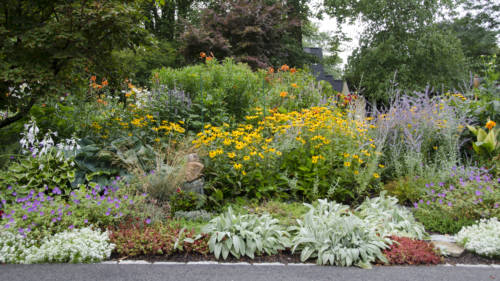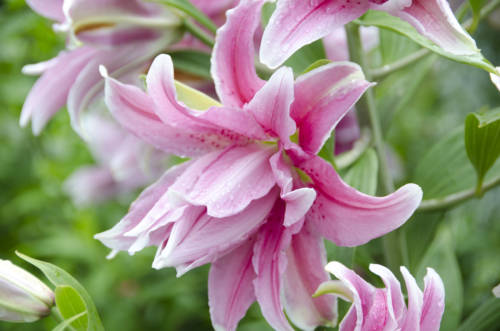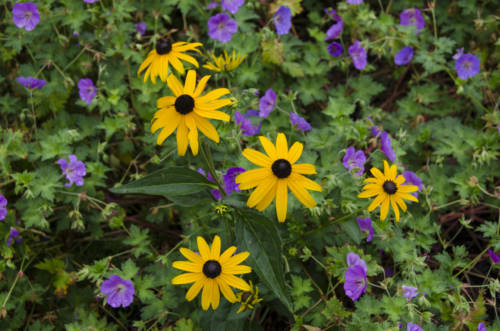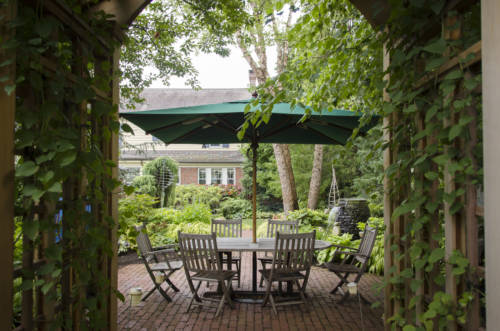
How Natick Gardener Joyce Hannaford Created Something From Nothing
I first noticed my neighbor’s garden one Halloween as my kids trick-or-treated down the street. Even though the back yard was shrouded in darkness, it was impossible to miss the area filled with trees, metal sculptures, plantings, and nooks built for exploring.
As the weather eventually warmed, I’d take strolls specifically to check the garden out. I couldn’t stop looking at the rainbow of color and the interesting knickknacks spaced throughout the yard as I passed by– the yellows, pinks, whites, oranges, and reds. When I snapped an impromptu phone image of a quirky blue sphere that dotted the garden and went home to look it up, I learned what an allium was. (I learned later that the alliums in the garden in July had been spray painted in May to prolong their vivid look.)
The garden, created by Joyce Hannaford of Natick, Massachusetts, is a labor of love and well-known beyond our neighborhood. “We get about 1,000 visitors a year,” says Joyce, who lives on the corner of a Main Street in Natick, a suburb about 15 miles west of Boston, and a private road that dead-ends with two other houses on it. A hand-painted sign on the side street instructs visitors to park on the opposite street across the main road, so cars don’t clog the quiet cul-de-sac.
What brings people to her garden? “Everything’s been planted for a particular view,” says Joyce. “There’s a view from my kitchen window, from every spot, and there’s year-round interest, even in the winter. There are lots of paths, so there’s a surprise everywhere, and another look around every corner.”
Setting the Stage
The garden today sits on a plot of land, that along with its house, is one-third of an acre. The yard is packed with blooms, sculptures and patios. With more than 500 kinds of flowers, Joyce has built different sections of the garden that include eclectic flower arrangements such as a combination of low-lying red dragon wing begonias and white alyssum with a towering pink and white oriental lily overlooking the spot from a few feet high. In the spring and summer, Joyce spends up to sixty hours a week pruning, watering, planting and perfecting. “I like the way this area has filled out, and while the lily is too tall, I leave it because it’s a fun conversation piece—it’s been growing there for six years,” said Hannaford. “I garden in layers; I don’t keep high things in the back and low things in front.”
Joyce and her husband Charlie moved into the house, a Gambrel colonial, in 1999. “It was a dump when we bought it, but it fit our criteria,” she said. It had land for gardening and space for the couple’s grandfather clock, canopy bed, and an oversized rug. “The house was a mess, but it had good bones.”
In the spring and summer, Joyce spends up to sixty hours a week pruning, watering, planting and perfecting.
Originally, the backyard was full of overgrown scrub and trees, so the couple worked on it in stages, “working and working, and you pick away at it,” said Joyce. Once cleared, Joyce planted the first flowers in her garden— a collection of 70 day lilies transferred from a friend’s garden, in 2000. “She was moving from Fairfield, Connecticut to Las Vegas, and the new owners to her home didn’t want them,” said Joyce. “I drove to Fairfield and dug up 70 in every color—red, pink, yellow—and put them into my own garden. They’ve been here ever since.”
Joyce takes up to 1,000 photos of the garden each year, always adjusting things so they more closely match her vision. “I’m looking at texture, height and scale,” she said. She has added more than 100 yards of organic soil over the year, and in 2001, installed a well to water the area thoroughly. She spends four hours a day watering, “but it’s never enough.”
Beyond the Blooms
Besides the flowers, grasses, trees and plants, Joyce fills her space with interesting hardware that complements the garden. A Lyman Whitaker wind sculpture, a double helix strand evoking a DNA strand, spins and twists in the breeze. “It’s nice to look at in the winter,” Joyce said. A water feature with two curved shapes resembling parentheses surround a water feature that constantly refills itself, supporting several goldfish inside. A pot of coleus and dragon wings sits in a ceramic man’s head, the greenery fills out the character’s hairstyle. A metal goat guards the far backyard. Several pyramids of stacked stones dot the landscape, inspired by those found on hiker’s trails “to find your way out,” she explains.
Joyce’s garden peaks in mid-to-late July, and to celebrate, she and Charlie host an annual outdoor garden evening garden party. This year, “it was magical,” she said, with 31 handmade copper lights illuminating the space.
Joyce’s garden peaks in mid-to-late July, and to celebrate, she and Charlie host an annual outdoor garden evening garden party. This year, “it was magical,” she said, with 31 handmade copper lights illuminating the space. Joyce, a private chef and caterer, served homemade foods and vegetables she grew herself, such as tomatoes, zucchini, peppers, lettuce, potatoes, eggplant and arugula. She spends a month preparing for the party, deadheading flowers and staking taller stalks, and does a lot of cleanup the day after. (“I did eight loads of laundry the day after,” she admitted.)
Joyce, who grew up in Franconia, New Hampshire with a family garden, began tending her own rows of vegetables at age four, homegrown foods have always been the foundation for her and her family. “I cook from scratch and I have never, ever, ordered take-out or eaten fast foods,” she said. “I make my own pasta, breads, and tomato sauce.”
Hannaford grows her produce at a community garden because local rabbits have always devoured her crops, though that hasn’t stopped her from growing them.
“The garden is my drug—I have no allergies and take no medications,” she said. “We call this our nursing home because we aren’t going anywhere.”



















































